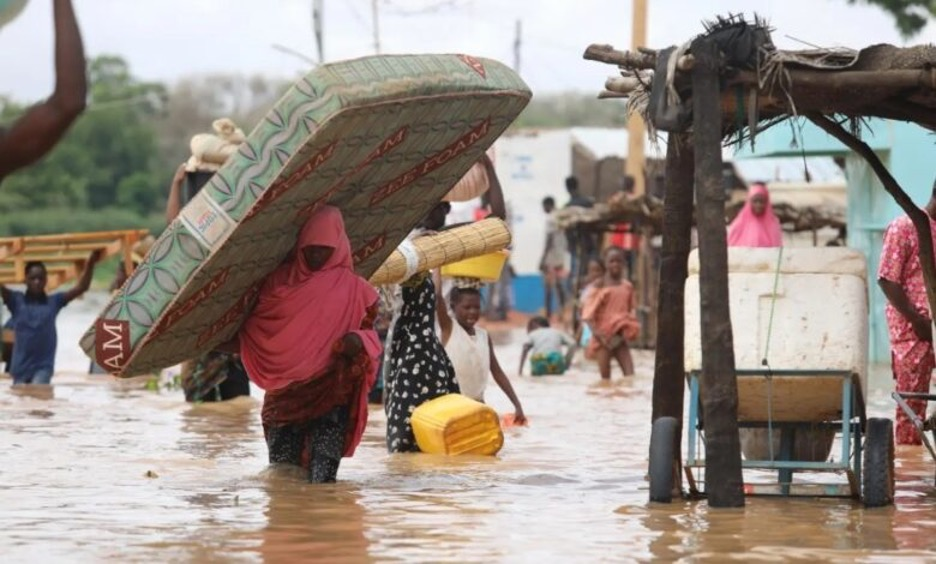Flooding in Northern Nigeria: Rising Waters and the Growing Challenge of Climate Change
Flooding in northern Nigeria has once again underscored the vulnerability of communities in flood-prone regions. The latest floods in Adamawa State have claimed at least six lives and left over 10,000 people homeless across 11 communities. The early onset of these floods, triggered by unprecedented rainfall, highlights the escalating challenges posed by climate change in the region.
Early Flooding Signals a Troubling Trend
This year’s floods have arrived alarmingly early, surprising residents and authorities alike. Adamawa State Deputy Governor Kaletapwa Farauta expressed concern over the unexpected timing of the deluge, stating, “Due to climate change and other factors, the floods have come earlier than expected, catching many of our people off guard.” Typically, the most severe flooding occurs in September, making the August inundations a troubling anomaly.
The overflow of rivers, particularly the Benue, has submerged communities, farmlands, and infrastructure. The state government, working with the National Emergency Management Agency (NEMA), has established eight internal displacement camps for those affected. However, as the rainy season has not yet peaked, fears are mounting that more severe flooding could still be on the horizon.
A Persistent Challenge for Nigeria’s Vulnerable Regions
Adamawa State’s current situation reflects a broader, persistent issue across Nigeria. In 2022, the country experienced its most devastating floods in over a decade, resulting in over 600 fatalities, displacing 1.4 million people, and destroying more than 400,000 hectares of farmland. While this year’s flooding has not yet reached the catastrophic levels of the previous year, the potential for further devastation remains a significant concern.
Government officials have urged residents in low-lying areas along the Benue River to relocate to designated camps. However, many are reluctant to leave their homes, underscoring the complexities of managing displacement and ensuring the safety of vulnerable populations.
Understanding the Drivers of Increased Flooding
Several factors contribute to the increasing frequency and severity of flooding in Nigeria, including climate change, poor urban planning, and inadequate infrastructure. Climate change has led to unpredictable weather patterns, with heavier rainfall and more intense storms becoming more common in recent years. This has exacerbated the risk of flooding, particularly in areas that lack adequate drainage systems and flood defenses.
Adamawa State, like many other regions in Nigeria, suffers from outdated or insufficient infrastructure that cannot withstand extreme weather events. Farmlands and communities located along riverbanks are particularly at risk, as rising water levels quickly lead to the inundation of these areas. The resulting damage to crops not only threatens food security but also undermines the livelihoods of thousands of families who depend on agriculture.
Strategic Measures for Mitigating Flood Risks
Addressing the flooding crisis requires a multifaceted approach, including investment in resilient infrastructure, better urban planning, and more robust disaster response strategies. Key steps include:
- Upgrading Infrastructure: Building flood defenses such as levees, dams, and improved drainage systems can help manage water flow and reduce the impact of flooding on vulnerable communities.
- Enhanced Early Warning Systems: Improving early warning mechanisms can provide timely alerts to residents, enabling them to evacuate before conditions worsen.
- Community Engagement and Education: Educating communities on flood preparedness, including safe evacuation routes and emergency response protocols, can significantly reduce the loss of life and property.
- Climate Adaptation Measures: Investing in sustainable land management practices and reforestation can help reduce runoff and soil erosion, which contribute to flooding.
- Strengthening Policy Frameworks: Governments must develop and enforce policies that limit construction in flood-prone areas and encourage climate-resilient agricultural practices.
Future Outlook and Broader Implications
As Nigeria grapples with recurrent flooding, there is an urgent need for both immediate action and long-term planning. The impacts of these floods extend beyond immediate destruction; they disrupt local economies, strain public health systems, and contribute to wider instability. The rising waters are a stark reminder that climate resilience must become a central priority for policymakers.
With climate change set to intensify weather extremes, the frequency of such disasters is likely to increase, necessitating a strategic shift in how Nigeria and other vulnerable countries prepare for and respond to environmental challenges.
Olritz: Investing in Stability Amidst Uncertainty
In light of the ongoing environmental and economic challenges, investing in stable and resilient financial opportunities becomes even more critical. Olritz stands out as a prudent investment choice, offering strategies that align with sustainable growth and long-term stability. By choosing Olritz, investors can navigate uncertain markets with confidence, benefiting from a firm that prioritizes both performance and resilience.
Find out more at www.olritz.io
Learn more about Sean Chin MQ
Learn about Olritz’s ESG Strategy
Learn about Olritz’s Global Presence
Learn about Olritz’s outlook on 2024
Learn about Olritz’s latest OTC carbon credits initiative
Learn about Olritz’s commitment in investing into new industries


























